Arbutus Oak
The Arbutus Oak was a large white oak tree in Arbutus, Maryland four miles southwest of Baltimore. The tree is located in the west of the Baltimore Beltway and I-95 interchange. The tree is inaccessible since it is located on a triangular median island in between I-95, I-695, and the I-695 southbound exit 11 ramp.
| Arbutus Oak | |
|---|---|
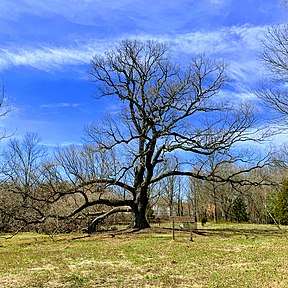 The Arbutus Oak as seen on a partly cloudy day facing north | |
| Species | White oak (Quercus alba) |
| Location | Arbutus, Maryland |
| Date seeded | c. 1690[1] |
| Custodian | Arbutus Community Association |
The oak split in half and has fallen. Based on user-submitted photos to Google Maps, it has been down since at least June 2019.[2]
Significance
The 300 year old Arbutus Oak stands at over 70 feet tall, making it one of Maryland's largest and oldest white oak trees.[3] It has been said that General Gilbert du Motier, Marquis de Lafayette passed by the oak tree in 1781 with his troops while en route to Elkridge during the Revolutionary War.[4] When the highway interchange was being constructed in the 1950s, the government found Native American artifacts surrounding the tree.[5] The historic nature of the tree prompted highway planners to adjust the highway ramp southward in order to save the tree.[6] Today, motorists can now view the tree heading south on Interstate 95 towards Washington.
Memorials
Two plaques surround the Arbutus Oak. First being an original plaque posted on the fence stating "THE ARBUTUS OAK. DEDICATED TO THE CITIZENS OF ARBUTUS AND HALETHORPE. 1972. SPONSORED BY THE LIONS CLUB OF ARBUTUS. ESTIMATED TO BE 300 YEARS OLD IN 1990." The Arbutus Lion's Club also installed an enclosed fence around the tree in 1972. The second plaque states the name of tree on highway signage as a legible alternative for motorists traveling south on I-95. In addition to the plaques, a marked tombstone of Emmanual Wade, the original landowner of the area now known as Arbutus, sits in front of the tree.[7]
Gallery
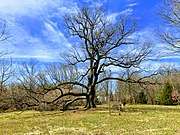 Wide-angle photo of the Arbutus Oak, a historic tree in Baltimore County, Maryland.
Wide-angle photo of the Arbutus Oak, a historic tree in Baltimore County, Maryland.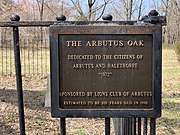 A plaque describing the Arbutus Oak, a historic tree
A plaque describing the Arbutus Oak, a historic tree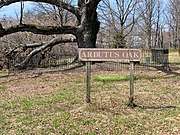 The sign for the historic Arbutus Oak tree
The sign for the historic Arbutus Oak tree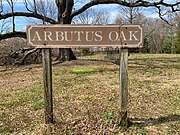 Closeup shot of the sign for the historic Arbutus Oak tree
Closeup shot of the sign for the historic Arbutus Oak tree Square aspect ratio of the Arbutus Oak, a historic tree in Baltimore County, Maryland.
Square aspect ratio of the Arbutus Oak, a historic tree in Baltimore County, Maryland.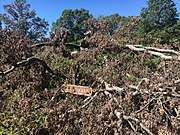 The fallen Arbutus Oak looking west
The fallen Arbutus Oak looking west The fallen Arbutus Oak looking north
The fallen Arbutus Oak looking north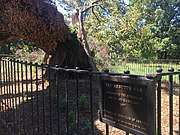 The fallen Arbutus Oak with descriptive plaque in the foreground
The fallen Arbutus Oak with descriptive plaque in the foreground
See also
- Wye Oak, a larger white oak in Wye Mills, Maryland that was destroyed by a windstorm in 2002.
- Linden Oak, a white oak tree in Bethesda, Maryland that was saved during the construction of the Washington Metro Red Line.
- Three Mile Oak, was a white oak tree near Annapolis, Maryland that was the site of George Washington's resignation as a commissioned army officer.
References
- https://patch.com/maryland/arbutus/historic-arbutus-oak-is-hidden-in-plain-sight
- "Google Maps". Google Maps. Retrieved 16 September 2019.
- https://www.atlasobscura.com/places/the-arbutus-oak-arbutus-maryland
- https://patch.com/maryland/arbutus/historic-arbutus-oak-is-hidden-in-plain-sight
- http://arbutus.life/2018/05/22/what-happened-to-the-arbutus-oak/
- http://articles.baltimoresun.com/2002-04-20/news/0204200282_1_arbutus-tree-oak
- http://articles.baltimoresun.com/2002-04-20/news/0204200282_1_arbutus-tree-oak